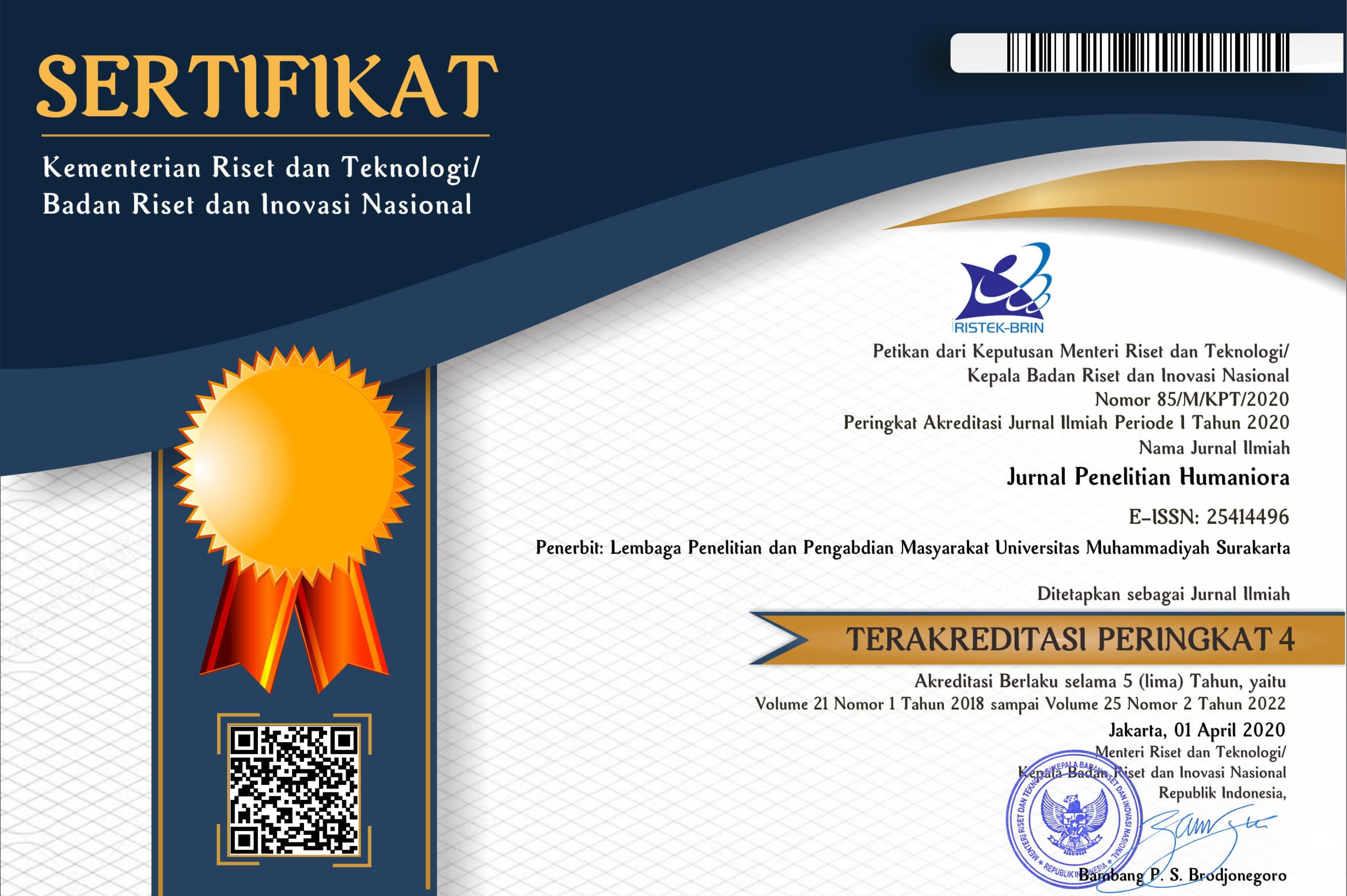PENGGALIAN TOPIK DAN FUNGSI IMAJINATIF DALAM WACANA CERITA ANAK DI MEDIA SOLOPOS DAN KOMPAS
Agus Budi Wahyudi(1*), Nuraini Fatimah(2)(1) Universitas Muhammadiyah Surakarta
(2) Universitas Muhammadiyah Surakarta
(*) Corresponding Author
Abstract
The objective of the research is to describe (1) fairy tale topic (2) the imaginative function, and (3) construct a narrative map based on extracting topic and imaginative function in a fairy tale at Solopos and Kompas newspaper. It used a descriptive-qualitative. The data sources were the fairy tales in Solopos and Kompas newspaper published from March to August 2022. The data consisted of 52 fairy tales (26 taken from Solopos and the others from Kompas. The objects of the study were the fairy tales in topics and imaginative function. The data analysis used a content analysis in combination with referential-equivalent method. The findings of the research show that (1) the fairy tales in Solopos and Kompas referred the topics to persona and non-persona, the constituents in words and phrases, nouns and verbs, and adverbs. The topical-sequential degree in Solopos and Kompas was very unique because they were generally not ‘strict’. (2) The imaginative function that was found in the discourse of fairy tale in Solopos and Kompas on the March to August 2011, a total of ten 133, in the Solopos are 69, and in Kompass are 64 function of imagination. Every fairy tale discourse contains only one to four imaginative function, even that does not contain terms that have imaginative function. Narative map in this research, is built based the identification of the principal builders of the story elements (topic, character, and narrative structure) and role of imaginative function in each part of thefairy tale. The fairy tale sharing into three parts categorized, there are the beginning of the story (BAC), the center of the story (BTC), and the end of the story (BAKC).
Keywords
Full Text:
PDFReferences
Adi, Ida Rochani. 2011. Fiksi Populer: Teori dan Metode Kajian. Yogyakarta: Pustaka Pelajar.
Baryadi, I Praptomo. 2002. Dasar-dasar Analisis Wacana dalam Bahasa. Yogyakarta: Pustaka Gondo Suli.
Brown, Gillian dan George Yule. 1983. Analisis Wacana. Diterjemahkan oleh I.Soetikno.1996. Jakarta: Gramedia Pustaka Utama.
Depdiknas. 2008. Kamus Besar Bahasa Indonesia Pusat Bahasa : Edisi Keempat. Jakarta: PT Gramedia Pustaka Utama.
Hidayat, Asep Ahmad. 2006. Filsafat Bahasa: Mengungkap Hakikat Bahasa, Makna dan Tanda. Bandung: Rosda Karya.
Howe, Chrisstine. 1983. Accounting Language in Conversational Context. London: Academic Press Line.
Istriwati, Enita. 2008. “Nilai Praktis dalam Cerpen Anak”. Nur Ramadani Setyaningsih (Ed.). Seranta Bahasa dan Sastra 3. Semarang: Pusat Bahasa Departemen Pendidikan Nasional.
Kuntowijoyo. 2004. “Sejarah Sastra”. Humaniora. Volume 16. No.1 Pebruari 2004. Hal 17- 26. http://jurnal.uny.ac.id/index.php/cp/article/view/369/pdf.
Marahimin, Ismail. 2003.”Pembekalan, pada Bengkel Penulis Cerita Anak”. Sabrur K Soenardi (Ed.). Teknik Menulis Cerita Anak. Yogyakarta: Penerbit Pinkbook, Pusbuk, dan Taman Melati.
Nurgiyantoro, Burhan.2005. “Tahapan Perkembangan Anak dan Pemilihan Pemilihan Bacaan Cerita Anak”. Jurnal Cakrawala Pendidikan. Juni 2005, Tahun XXIV No.2 http:// docs.google.com/viewer?a=v&q=cache:or9p08oHfQwJ: journal.uny.ac.id/index.php/cp/ article/view/369/pdf+sastra+adolesen&hl. diunduh 21 Maret 2011 pukul 09.21WIB.
Sasti, Poetri Mardiana .2008.”Pesan Moral dalam Cerita Anak Rubrik “Dongeng” Majalah Bobo edisi Mei–Juni 2008". Seranta Bahasa dan Sastra 3. Semarang: Pusat Bahasa Departemen Pendidikan Nasional.
Sayuti, Suminto.A. 2000. Berkenalan dengan Prosa Fiksi. Yogyakarta: Gama Media.
Sutama, Dwi. 2006. Kesinambungan dan Penonjolan Topik dalam Wacana Narasi Bahasa Jawa. Yogyakarta: Balai Bahasa Yogyakarta.
Article Metrics
Abstract view(s): 843 time(s)PDF: 593 time(s)
Refbacks
- There are currently no refbacks.











